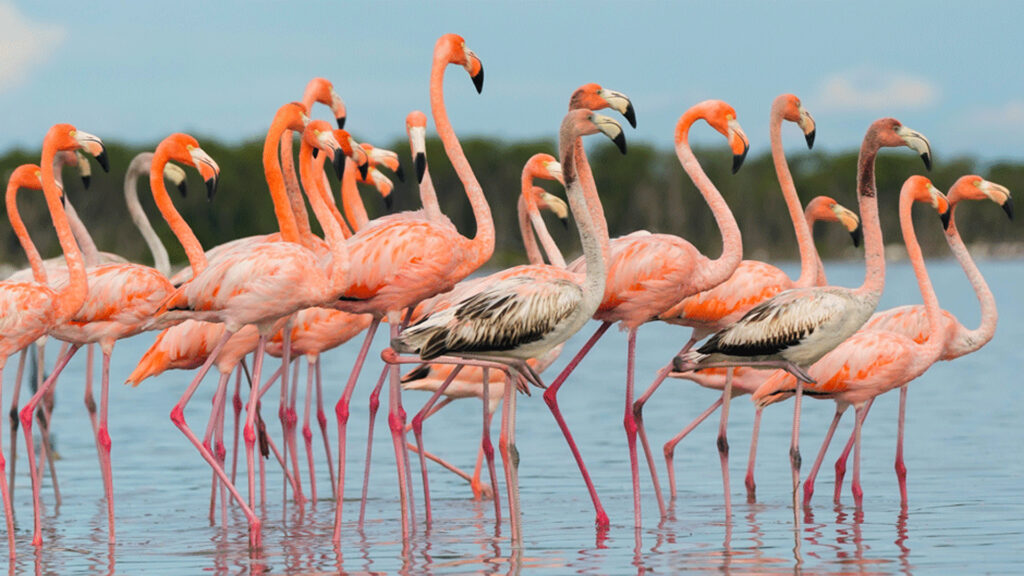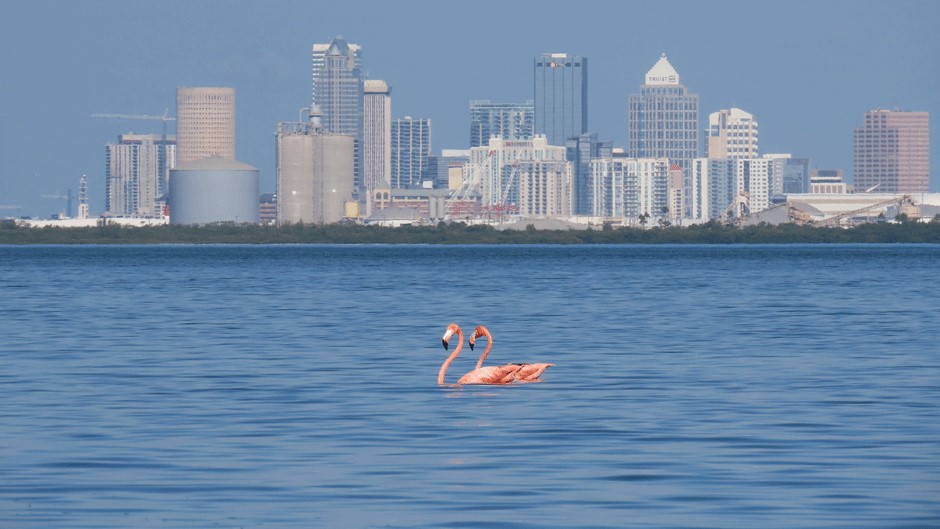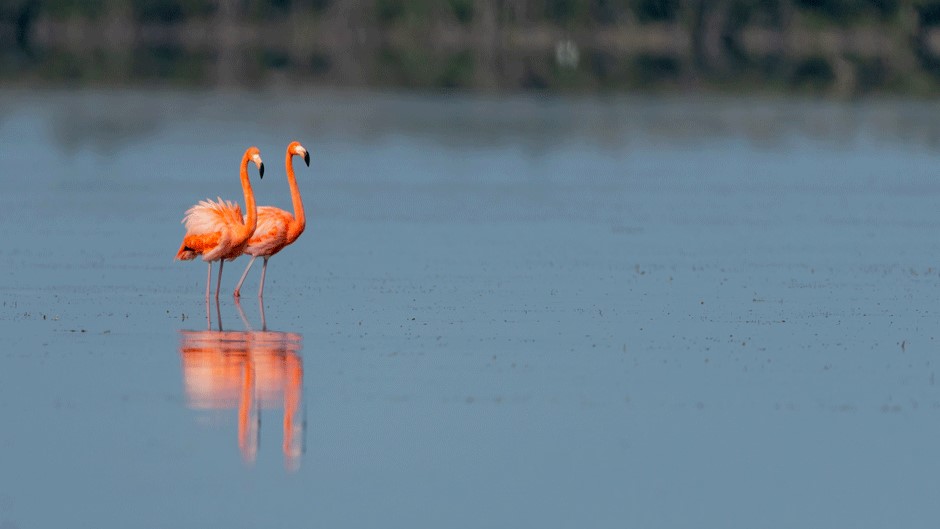By Janette Neuwahl Tannen, University of Miami News
It was a flash of electric pink against a backdrop of brilliant blue water and green mangroves.
Even though she and colleagues had been searching for the elusive American flamingo, Kelly Cox, a University of Miami lecturer and alumna, was caught off guard by the beauty that came into focus when she saw a flock of two dozen wild flamingos in Everglades National Park recently.
“It was really magical to see it out there in the park,” said Cox, now director of Everglades policy for Audubon Florida, who graduated from the School of Law and the Rosenstiel School of Marine, Atmospheric, and Earth Science in 2016.
In the past century, wild flamingos all but disappeared from the Florida landscape. But, with a major increase in sightings during the past few months, scientists, birdwatchers and Everglades conservation advocates, like Cox, are ecstatic.

University alumna Noël Schael and her husband Rainer Schael were poling their boat in Everglades National Park in November when a flock of 47 flamingos landed in front of them. In recent weeks, Lori Oberhofer, wildlife biologist at the park, received multiple reports of up to two dozen flamingos together. There was one observation of a flock of 75 flamingos, she added.
And according to National Park Service rangers, the flamingos haven’t left.
“Of course, we’re not sure if they’ll fly back south, but for now, they’re sticking around, which means there’s enough food and habitat for them,” Cox added.
Researchers say it is one tangible sign that the massive $10 billion Comprehensive Everglades Restoration Plan (CERP) is finally seeing success, 23 years after the act of Congress was signed into law to help bring wildlife back to the river of grass.
While flamingos were once common in the Sunshine State — giving rise to the references in lawn décor, literature, art and business names — the growth of the plume hunting industry in the 1800s, followed by the draining of the Everglades in the 20th century, decimated Florida’s flamingo population. As flamingos faded from the landscape, so did many of the other wading birds that rely on shallow water for their next meal.
For the next century, American flamingos were only spotted in remote islands off Cuba, throughout the Caribbean and near Mexico’s Yucatan Peninsula.
In recent years, a few of the unmistakable birds were spotted in South Florida and the Keys, as well as the Florida panhandle. But when Hurricane Idalia churned through the Gulf of Mexico in August, researchers believe the storm’s winds diverted some flamingos from their typical flight patterns through the Caribbean and steered them north. In September, birdwatchers across the country began posting flamingo photos as far north as Wisconsin and Pennsylvania.
Still, most were found in Florida, with nearly 70% of the flamingos observed in the Florida Keys and in Florida Bay, which is part of Everglades National Park, said Jerry Lorenz, Audubon Florida’s director of research and an alumnus of the Rosenstiel School.

“We never welcome hurricanes here in Florida, but we did welcome some passengers,” Lorenz joked during a webinar about Florida’s “pink wave.”
“It was rather amazing to start seeing this because just about 15 years ago, we started tracking these birds and we would get six to seven sightings per year, and then this year, within a few days, we had hundreds of sightings,” he said.
Scientists believe the larger number of wild flamingos that are in Florida, the more likely it is that the iconic pink birds may nest again here.
“It’s encouraging that a number of the birds sighted in Everglades National Park were immature birds, so even if the flocks return to where they came from, the younger birds could strike out on their own later and perhaps return to Florida,” Oberhofer said.
Biology graduate student Alexis Oscar Diaz Campo is studying the genome of all six flamingo species and has monitored flamingo populations in South America. Because American flamingos usually nest in remote areas of the Caribbean, Diaz Campo said there is a lot more to learn about them. However, he did mention that their large wingspan allows them to cover vast distances quickly — some fly more than 300 miles in a day.
“Flamingos have a great dispersive capacity to travel far, but their movements are not as predictable as other birds with regular annual migrations,” he said, adding that where they land often depends on the availability of shallow lakes.
Like other South Florida bird researchers, Diaz Campo said to fully understand the range and population of American flamingos, more monitoring of the species must occur. Toward that goal, Zoo Miami helped lead an effort to get the American flamingo protected as an endangered species. This would require state environmental officials to regularly monitor the species, but their 2021 petition was not accepted. Now, a new campaign is currently underway to make the flamingo Florida’s official state bird and give it more visibility, said Frank Ridgley, Zoo Miami’s head of conservation and research.

Working together, Ridgley and Lorenz placed satellite GPS bands on the only two wild flamingos ever tracked in the United States—Conchy, found in Key West in 2017, and Peaches, a male who was found south of Tampa in September. In the next two months, Ridgley said the Florida Flamingo Working Group—a coalition of scientists and conservationists from across the state—is hoping to conduct a census to better estimate Florida’s wild flamingo population.
But Cox said the resurgence of wild flamingos in Florida highlights a wider trend. Many wading bird populations are now returning to the Everglades, and in recent years, the number of roseate spoonbills, herons and wood storks have also started to rebound.
She attributes this success to CERP, signed into law in 2000 to help protect one of the world’s most unique hydrological ecosystems. Today, it is the largest collective ecosystem restoration project in the world and aims to restore the river of grass to its former glory.
Since graduating from the university, Cox has worked on many South Florida environmental protection issues. For the last two years, she has focused on CERP for Audubon Florida, so seeing flamingos in the Everglades was a full circle moment.
“It was a very, very stark visual reminder of, ‘If you build it, they will come,’” said Cox. “If you can create a healthy habitat, it can support these really iconic and beautiful bird species that have been away from home for a really long time.”
This piece was originally published at https://news.miami.edu/stories/2024/01/the-flamingos-triumphant-return.html.
Sign up for The Invading Sea newsletter by visiting here. If you are interested in submitting an opinion piece to The Invading Sea, email Editor Nathan Crabbe at ncrabbe@fau.edu.



